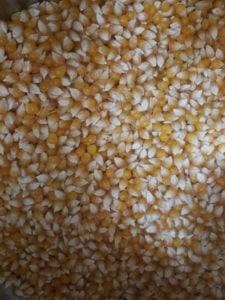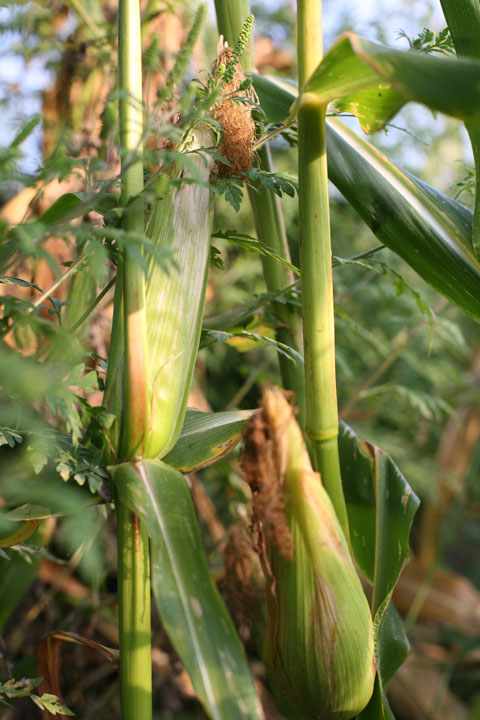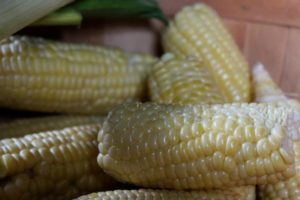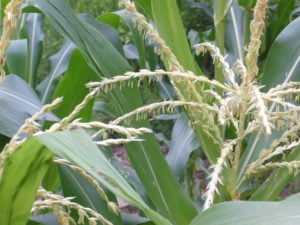We’ve covered tomatoes this summer, and now for this week’s edition of the Grow Appalachia newsletter, we’ll be taking a look at another popular garden favorite: corn!
Corn has become a staple in the backyard vegetable garden, and the possibilities for its use are endless: Besides the typewriter (or other???) eating method of consuming corn, many gardeners also can it, dry it, freeze it, and even pickle it! (Guess you can pickle just about anything these days). Its sunny yellow color and off-the-cob goodness make it a summertime treat for gardeners and food buyers of all ages. We’re once again giving a crash course, but this time regarding the marvelous mays.
The Basics
-Corn is a warm season crop (soil temperatures above 65F; corn seed will not germinate at temperatures below 55F), so late spring into early summer is the most ideal planting time. Many corn varieties reach maturity at 70-90 days.
-Corn loves nitrogen! Make sure your soil contains plenty of organic matter. Plant corn in a plot of your garden that has been cover cropped, or add in a layer of grass clippings or compost before planting.
-Since corn is a “heavy feeder” it may require sidedressing of fertilizer once or twice during growth. Phosphorus deficiency results in purple-tinged leaves, whereas nitrogen deficiency results in pale green leaves. Learn what nutrient deficiency looks like and adjust accordingly.
-Ensure that your corn rows are thoroughly spaced apart. Corn that is planted too closely together can become cross-pollinated, which can greatly alter the flavor.
-More on the above note: stick to planting only one variety per year.
-Plant seeds 1 inch deep directly into the ground. Do not start plants indoors, or plant transplants like other crops.
-Approximately 20 days after corn silks (at the tops) appear, pull back part of the husk and pierce a corn kernel with a fingernail. If the kernel is watery, it’s not ready yet. If the kernel is milky, it is time for harvest! Any longer after that, and the sugars in the corn break down into starches, resulting in a less-sweet flavor.
-Once corn is picked, store it as soon as possible in the refrigerator, or cook and eat promptly. Sweet corn starts to lose its flavor very rapidly after harvesting.
Diseases and Management
1. Corn smut- Caused by a fungus, corn smut results in grayish tumor-like growths on the ears. The fungus is most prevalent in persistent moist and hot conditions. The mature growths release spores that resemble soot. To prevent the spread of this disease, remove infested ears or immature growths before they develop spores, which can be easily spread by wind. Keep your garden free of plant debris; smut overwinters on plant debris left in the soil.
2. Corn rust- Also caused by a fungus, unlike corn smut, corn rust thrives in cooler temperatures with high humidity. Rust causes raised brick-colored spots on corn leaves. Although the diseases rarely causes serious problems or crop loss, avoid subjecting the corn to stress from drought.
3. Stewart’s wilt- Caused by a bacteria, Stewart’s wilt can kill emerging seedlings and result in leaf lesions on maturing plants. The bacteria overwinter on flea beetles, and once the flea beetles start feeding on healthy plants is when the disease can become transmitted. Leaf lesions appear as long rectangular streaks on the plant, which then turn brown and die. To prevent further infection, remove any infected plant material as soon as damage is spotted. Since this disease is transmitted by a pest, it’s also important to practice pest management strategies to reduce populations of potentially harmful flea beetles as well.
A few “best practices” for disease management:
-Keep your garden free of plant debris and weeds, which can be breeding grounds for disease.
-Plant resistant varieties (More on variety selection a little later)
-Plant corn at the appropriate temperature to prevent seedling rot or poor germination.
-Remove corn plant debris after harvesting.
***
Variety Selection
Once again comes the ever-popular question: Which varieties should I grow? With corn, there are three different categories when it comes to flavor and genetics: SU (normal sugar content), SE (a hybrid variety with a sugar enhancer gene), and sh2 (a supersweet hybrid that contains the shrunken -2 gene; it has a higher sugar content than SU varieties). Corn is also classified into white, yellow, and bi-color by kernel color. Most sweet corn sold today is typically a hybrid variety. For a more comprehensive list, you can refer to the resource from Illinois Extension below, but a few recommended varieties are as followed:
White: Silver Queen (SU), Peaches & Cream (SE, popular among Grow Appalachia participants), Country Gentleman (open-pollinated, SU), How Sweet It Is (sh2, All-American Selection winner)
Bi-color: Double Standard (organic and open-pollinated, SU), Butter & Sugar (SU), Sugar Buns (SE)
Yellow: Illini Xtra Sweet (sh2, the “original” supersweet hybrid), Early Sunglow (SU, 62 day maturity!)
We’re wrapping up this corn collective with a…collection (pardon the alliterations!) of recipes featuring sweet corn!
- Fresh Corn and Tomato Salad- Featured in an earlier newsletter, this recipe also makes use of fresh tomatoes and basil, if you have any.
- A collection of corn-related recipes from the Pine Mountain archives, including a tomato galette with corn and zucchini, corn fritters, and sauteed corn with roasted butternut squash.
- Three Sisters Succotash- The “three sisters”, which comprises corn, beans, and squash, come together in this beautiful dish.
- Corn Pudding- A popular Southern side dish
Of course, there is one other variation of corn that you can grow in your garden, especially if you have little ones: Popcorn! It’s tasty, it’s healthy, and it’s FUN! Several of Grow Appalachia’s partner sites grow popcorn in their gardens and it’s always a big hit! The key to growing perfect popcorn is to let the kernels dry in the field as long as possible; ideal moisture content for popcorn is 13-15%. Johnny’s offers a popcorn variety, Robust 997, but check your favorite seed catalogs or suppliers for other popcorn varieties.

Popcorn is grown every year at GH17, our domestic violence shelter site. The kids (and adults) love it!
That’s a wrap on our corn collective, so now we want to know: What are YOUR favorite varieties to plant? Something nibbling at your crop? How do you prepare your fresh off-the-husk ears? Share with us on our Facebook, Twitter, or Instagram pages, or shoot us an email! Until next time, happy growing (and eating)!
***
Resources/Further Reading:
All About Growing Sweet Corn from Mother Earth News
Home Garden Series from University of Georgia Extension
Clemson Extension: Sweet Corn Diseases
Illinois Extension Vegetable Directory: Corn
Grow Appalachia partner site blog on popcorn (with a few recipes!)







Leave A Comment